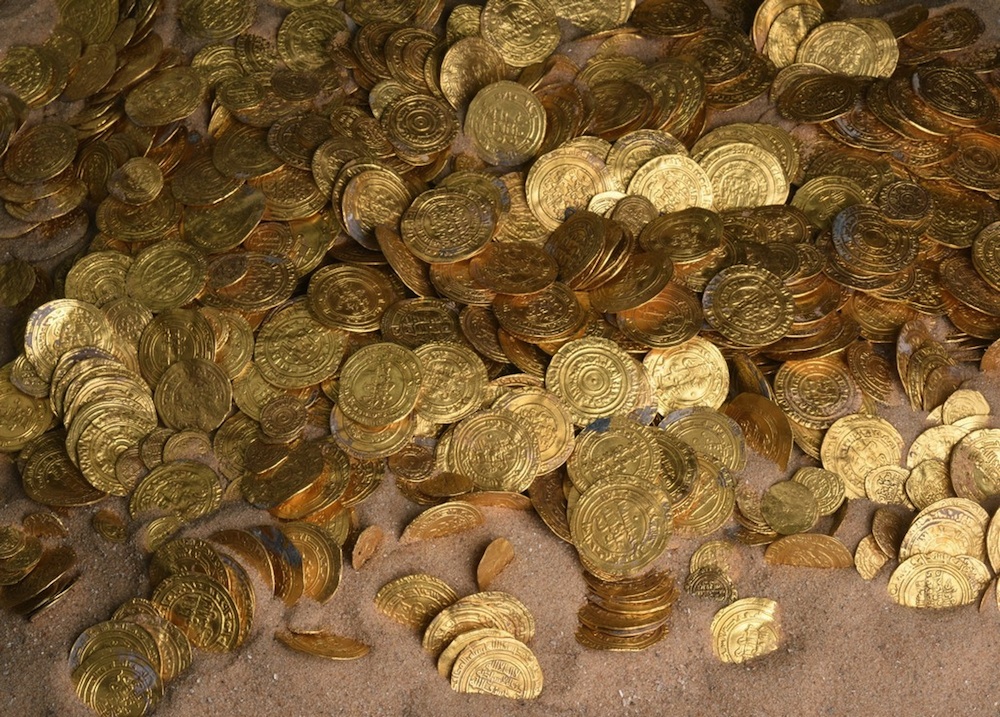
A massive trove of thousand-year-old gold coins has been unearthed in an ancient harbor off the coast of Israel.
The hoard, which was first discovered by members of an amateur scuba diving club, is the largest haul of gold coins ever unearthed in Israel.
The find raises the possibility that an ancient shipwreck that was once laden with treasure may lurk beneath the waves. [See Images of the Gold Treasure Trove Off Israel]
Valuable find
The coins were found off the coast of Caesarea, a harbor city that was built by King Herod the Great about 2,000 years ago. At the time when most of the coins were minted, Caesarea was a bustling port city that was central to the Fatimid Kingdom. At its peak, the wealthy Fatimid Kingdom ruled a region that spanned most of North Africa and much of the Mediterranean, and had 12 million dinars in its central coffers.
The diving club that initially found the coins first thought they were toys; when they took a closer look, they found several gold coins shimmering in the light. The director of the club reported the find, and the Israel Antiquities Authority returned to the site with metal detectors. All told, the team found nearly 2,000 gold coins in mint condition.
"Despite the fact they were at the bottom of the sea for about a thousand years, they did not require any cleaning or conservation intervention from the metallurgical laboratory," Robert Cole, a numismaticist with the Israel Antiquities Authority, said in a statement.
Sign up for the Live Science daily newsletter now
Get the world’s most fascinating discoveries delivered straight to your inbox.
That's because gold, as a noble metal, doesn't react with water or air, Cole added.
It's likely that winter storms shifted the sands off the coast, revealing the trove.
The earliest coin in the stash was minted in Italy around the ninth century. Most of the gold coins, which were minted in North Africa and Egypt, were produced during the reigns of the Fatimid caliphs Al-Ḥākim and Al-Ẓāhir, who ruled between A.D. 996 and A.D. 1036. The coins were found in dinar, half-dinar and quarter-dinar denominations, and some of these types of coins were still circulating after the Crusaders conquered Israel in A.D. 1099.
Many of the coins were bent or had teeth marks, which were probably left by ancient tradesman who inspected the money to make sure they were not adulterated with inferior metals. (Biting on pure gold leaves teeth impressions in the metal, while biting other metals would likely harm your teeth rather than the coin.)
The value of the trove represents a princely sum in ancient times. For instance, 11th- and 12th-century documents known as the Cairo Geniza, which were found in the geniza, or storeroom, of an ancient synagogue in Cairo describe paying hundreds of dinars to free Jewish captives.
Mysterious source
It's not clear exactly how the coins wound up at the bottom of the sea.
"There is probably a shipwreck there of an official treasury boat, which was on its way to the central government in Egypt with taxes that had been collected. Perhaps the treasure of coins was meant to pay the salaries of the Fatimid military garrison, which was stationed in Caesarea and protected the city," Kobi Sharvit, director of the Marine Archaeology Unit of the Israel Antiquities Authority, said in the statement.
Another possibility is that the booty once belonged on a merchant ship that traded throughout the Mediterranean region, but sunk long ago.
This isn't the first time that archaeologists have found a historic trove of gold. In May 2014, a steamship loaded with tons of gold bullion that sunk in 1857 was discovered off South Carolina. And in 2013, Israeli archaeologists unearthed hundreds of gold coins and jewelry in a Byzantine trash pit outside of Tel Aviv.
Follow Tia Ghose on Twitter and Google+. Follow LiveScience @livescience, Facebook& Google+. Originally published on Live Science.

Tia is the managing editor and was previously a senior writer for Live Science. Her work has appeared in Scientific American, Wired.com and other outlets. She holds a master's degree in bioengineering from the University of Washington, a graduate certificate in science writing from UC Santa Cruz and a bachelor's degree in mechanical engineering from the University of Texas at Austin. Tia was part of a team at the Milwaukee Journal Sentinel that published the Empty Cradles series on preterm births, which won multiple awards, including the 2012 Casey Medal for Meritorious Journalism.










